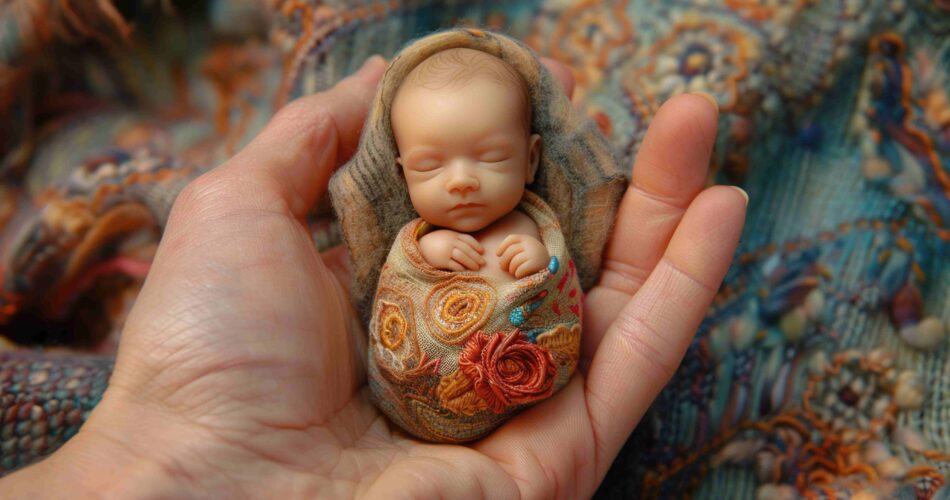- Types of Non-developing Pregnancy
- At what stages does pregnancy most often become arrested
- Reasons for a missed miscarriage
- Other Reasons Pregnancy May Cease
- Infections Leading to Fetal Death
- Symptoms of a Missed Miscarriage
- Signs of Fetal Development Cessation
- What else to pay attention to
- Diagnosis of Missed Miscarriage
- Missed Fetus: Risk Group
- How to treat a missed miscarriage
- Prevention of Miscarriage
A conceived and eagerly awaited pregnancy may not always last the full nine months and end with the birth of a baby. A missed pregnancy, unfortunately, is not an exceptional outcome after conception. According to statistics, about 15% of planned and desired pregnancies “stop” and cease to develop for various reasons.
This situation poses a risk to the health and even life of the expectant mother. Therefore, the earlier such a condition is diagnosed and appropriate treatment begins, the less impact it will have on the pregnant woman. At the very least, it’s important not to miss scheduled check-ups with a gynecologist, who can timely conduct diagnostics and reliably confirm the presence of a missed miscarriage in a woman.
Types of Non-developing Pregnancy
There are two types of missed miscarriage. The first is a non-developing pregnancy, where a fertilized egg enters the uterus, attaches to the uterine wall, and begins to develop. Suddenly, for unknown reasons, the process halts abruptly, leading to fetal demise. A miscarriage does not occur; the uterine muscles remain inactive. No symptoms of miscarriage appear, the deceased embryo is not expelled and continues to remain in the uterine cavity. This type of missed miscarriage is classified as a failed miscarriage.
The second type of this pathology is the so-called “blighted ovum.” In this case, although fertilization and implantation of the fertilized egg in the uterine endometrium occur, embryo formation does not take place. In this condition, called anembryonia, only the fetal membranes develop, but the embryo itself is absent inside them.

At what stages does pregnancy most often become arrested
Women are often concerned about which stages are critical regarding the potential arrest of pregnancy. In theory, the embryo can stop developing at any stage of gestation. However, there are certain time periods characteristic of missed pregnancy. These include:
- 7-12 days after fertilization – implantation of the embryo;
- 3-8 weeks after conception – fetal formation period;
- up to the 12th week from the start of pregnancy – placental formation stage.
The likelihood of a missed miscarriage in the first trimester is explained by experts as the embryo’s insufficient protection at this stage. By the eighth week, the embryo’s major organs are being laid down, making this period critical in terms of the risk of its development stopping. A pregnancy can stop progressing at various stages, even shortly before birth. However, it most frequently occurs before 28 weeks.
Reasons for a missed miscarriage
The causes of a missed miscarriage can be due to a variety of pathologies:
- Genetic – these causes are most often responsible for the cessation of embryo development. They include the presence of an extra chromosome in the embryo or pathological genes that lead to multiple defects incompatible with life, resulting in pregnancy termination. Genetic pathologies are most often the cause of halted pregnancy development around the eighth to tenth week.
- Hormonal – the balance of hormones is extremely important for the normal carrying of a child. Therefore, an excess of male hormones (androgens) or a deficiency of progesterone significantly increases the risk of miscarriage. That is why, if a woman has had hormonal imbalances, to avoid a missed miscarriage, it is recommended to treat them even before fertilization.
Other Reasons Pregnancy May Cease
A frozen pregnancy can also be triggered by teratozoospermia. This factor in the cessation of fetal development is associated with pathological changes in a man’s seminal fluid. It results in sperm in such ejaculate having abnormal structure, and fertilization with such a cell becomes the cause of developmental anomalies in the embryo.
Antiphospholipid syndrome can also lead to fetal arrest. Its presence can result in the reduced formation of placental vessels or their blockage, disrupting the embryo’s access to necessary nutrition. Negative factors leading to fetal arrest may include harmful habits and an unhealthy lifestyle during the planning period and pregnancy, such as smoking, alcohol consumption, stress, occupational risk factors, daily routine, sedentary lifestyle, and unbalanced nutrition.

Infections Leading to Fetal Death
Missed miscarriage is often provoked by infectious diseases diagnosed in the expectant mother. This is because there is a significant decrease in immune protection during pregnancy. Particularly dangerous during this time are TORCH infections, which include toxoplasmosis, rubella, cytomegalovirus, herpes. Therefore, screening for all these types of infections is mandatory when registering a pregnancy.
Even seemingly common and simple ailments such as the flu or acute respiratory viral infections can become the cause of pathology, especially when the fetus’s vital organs are still forming.
An infection can affect the fetus directly, causing various anomalies. Or it can impact the fetal membranes, leading to a significant deficiency of nutrients or oxygen reaching the fetus.
Symptoms of a Missed Miscarriage
Typically, a woman carrying a baby does not realize that the fetus inside her has already died, because a missed miscarriage in early stages lacks the vivid symptoms usually associated with a spontaneous miscarriage. The woman continues to feel pregnant, as the placenta still produces hormones despite this condition.
In some cases, an indirect sign of a missed miscarriage can be the disappearance of early pregnancy symptoms such as fatigue, breast tenderness, and nausea. If the fetus stopped developing at a later stage, where movements were already felt, the lack of fetal movement in the uterus may indicate a problem.

Signs of Fetal Development Cessation
Before visiting a gynecologist and laboratory detection of fetal demise, a woman may independently notice symptoms of a missed miscarriage, which should prompt an immediate, even unscheduled, visit to the gynecologist. A precursor to a pregnancy that has ceased developing is spotting from the vagina and increasing bleeding over time. These symptoms are usually accompanied by painful spasms in the lumbar region and lower abdomen. The appearance of such symptoms is a reason for the immediate call to emergency services and a call to the doctor managing the pregnancy.
Although spotting is not always a definite sign of a missed miscarriage, taking a wait-and-see approach would be a mistake. An important indicator of a deceased fetus is the basal body temperature, which a woman measures through the rectum. Typically, the temperature is above 37 degrees if the fetus is alive and developing.
What else to pay attention to
An expectant mother must carefully monitor changes in her condition. If the morning sickness that previously affected her suddenly stops manifesting, this is a reason for concern. Of course, as the pregnancy progresses, the symptoms of morning sickness gradually disappear, with daily reductions in nausea reactions to external stimuli. A sudden and sharp cessation of these symptoms warrants an unscheduled visit to the gynecologist. At the same time, one should monitor the condition of the breasts.
During the period of carrying a baby, they are enlarged, swollen, and slightly painful. In the case of a missed miscarriage, breast tenderness disappears, and they no longer feel full.
The usual pregnancy test can resolve any arising doubts. While it doesn’t guarantee 100% accuracy, sometimes it can detect fetal demise. Instead of the previously evident two lines, the test shows one due to the decrease in hCG levels.

Diagnosis of Missed Miscarriage
The presence of the pathology can only be reliably confirmed through diagnosis in a medical facility. Except in emergencies, it is essential to attend all scheduled check-ups recommended by your gynecologist. During a gynecological examination, the specialist will invariably identify a non-developing pregnancy by the lack of increase in uterine size and its mismatch with the current gestational age. The low position of the uterine fundus also serves as a serious factor prompting further investigation.
In such a situation, the doctor prescribes a blood test for hCG and hormones, as well as an ultrasound to determine the fetal heartbeat. Moreover, the ultrasound is performed twice. At later stages, the embryo’s heart is listened to using an obstetric stethoscope. To confirm the diagnosis of a ‘missed miscarriage,’ cardiotocography is conducted – registration of uterine tone and fetal heartbeat.
Missed Fetus: Risk Group
Unfortunately, a fetus can ‘stop’ developing in almost any woman. However, specialists identify groups of women who have a significantly higher risk of experiencing a missed miscarriage. These include pregnant women:
- who have already had a missed embryo in their history; if there have been more than two cases, it is referred to as habitual non-developing pregnancy – this is a high-risk category requiring the most careful attention;
- younger than 18 and older than 40 years, in the latter case reproductive function begins to decline during this period, and the likelihood of genetic pathologies increases.
The risk of fetal demise also increases with ovarian diseases, including polycystic ovary syndrome. Abortion history also negatively affects pregnancy development, and the risk of missed miscarriage increases proportionally with the number of abortions. Kidney diseases, arterial hypertension, and fungal infections can lead to pathology.
How to treat a missed miscarriage
Once fetal demise is definitively confirmed, the question arises as to whether and how to treat a missed miscarriage. In some cases, at early stages, doctors wait for the spontaneous expulsion of the embryo, but not longer than 2 weeks. Treatment is usually surgical and is carried out with the help of:
- aspiration – a procedure to remove remnants of the fertilized egg, performed in the early stages up to 5 weeks;
- curettage – cleaning with complete scraping of the uterine cavity is performed after five weeks;
- induced labor.
Procedures of aspiration and curettage are performed under general anesthesia. Each operation takes approximately about half an hour. During the rehabilitation period, a course of antibiotic therapy is mandatory. After that, the patient visits the doctor weekly. If no complications appear during this time and the causes of the pathology are eliminated, the woman can return to her usual rhythm of life.

Prevention of Miscarriage
To avoid a recurrence of a missed miscarriage in the future, experts recommend planning the next conception no earlier than 6-8 months after a failed attempt. The ideal situation is when a year or even one and a half years pass from the time of the abortion or miscarriage. This period is sufficient for both parents to undergo the necessary examinations and treatment. Typically, the woman is referred for an ultrasound, urine and blood tests, and a smear test. She is advised by a geneticist, gynecologist, and endocrinologist.
When planning the next conception, the patient is prescribed an increased dose of folic acid and potassium iodide. Moreover, the future mother’s body is given time to recuperate and gain physical readiness for carrying a baby. It’s important not to lose heart if there was a case of a non-developing pregnancy in the past. Following the doctor’s recommendations will aid in realizing the dream of motherhood.



Download the app and get 7 days free use
 eng
eng rus
rus deu
deu spa
spa fra
fra ita
ita por
por srp
srp tur
tur ukr
ukr por
por bos
bos



